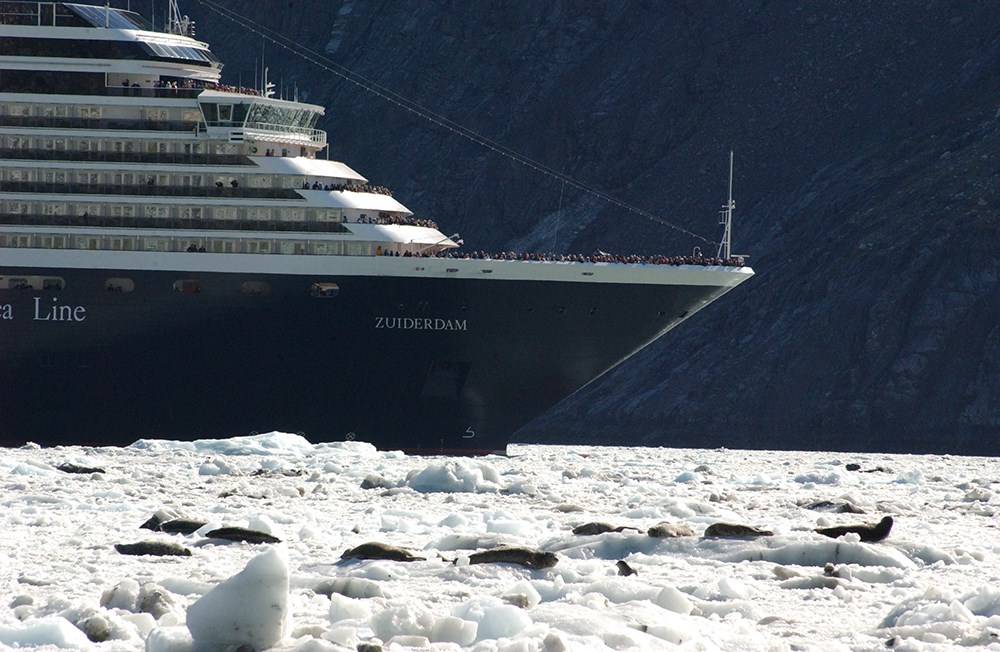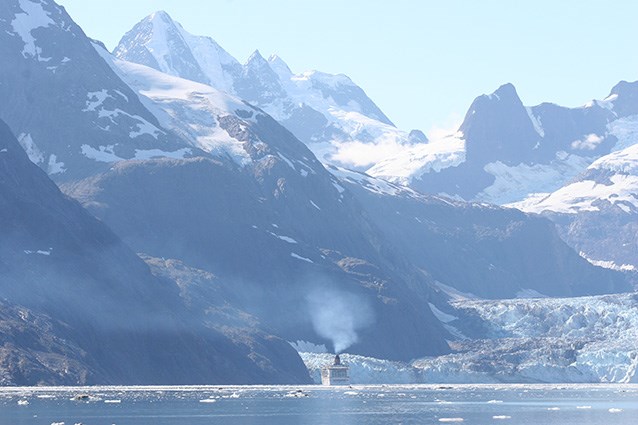Part of a series of articles titled Alaska Park Science - Volume 16 Issue: Science in Alaska's Arctic Parks.
Article
Why the National Park Service Cares about Shipping in the Arctic
By Scott M. Gende, National Park Service
The Arctic is changing more rapidly than any other place on earth. Warming, increases in storm frequency and severity, permafrost thaw, and loss of sea ice all portend dramatic changes in Arctic ecosystems and biodiversity. These physical changes are also increasing opportunities for human use of the Arctic including hydrocarbon development, tourism, and, importantly, shipping (Reeves et al. 2014). In fact, an increase of up to 500% of ship traffic in the Arctic was recently forecasted over the next decade with the largest increase coming from “destination” shipping, such as tourism and resource extraction (CMTS 2014).
The Arctic is changing more rapidly than any other place on earth. Warming, increases in storm frequency and severity, permafrost thaw, and loss of sea ice all portend dramatic changes in Arctic ecosystems and biodiversity. These physical changes are also increasing opportunities for human use of the Arctic including hydrocarbon development, tourism, and, importantly, shipping (Reeves et al. 2014). In fact, an increase of up to 500% of ship traffic in the Arctic was recently forecasted over the next decade with the largest increase coming from “destination” shipping, such as tourism and resource extraction (CMTS 2014).

NPS photo courtesy of Jamie Womble
The NPS is actively engaged in efforts to document and forecast these changes because of the potential to impact the large volume and high diversity of park resources and values in the Arctic. The U.S. Coast Guard recently proposed a two-way vessel route through the Bering Strait region. The resulting Port Access Route Study (PARS) would funnel nearly all large ships passing 15-25 nautical miles from the nearly 1,000 miles of coastline of Bering Land Bridge National Preserve and Cape Krusenstern National Monument. This area is subject to strong currents, extreme weather, and dynamic ice flow, yet currently lacks adequate emergency response facilities and is poorly charted, increasing the risk of grounding and catastrophic oil spill. Oil could easily reach the extensive coastal lagoons and sensitive salt marshes of these parks before any sizable response is available.
Pollution from shipping is also a concern because of its potential impacts to air and water quality. Arctic Alaska does not currently fall within the North American Emission Control Areas (ECA) designated for the rest of the U.S. coast (e.g., Fagerholt et al. 2015). Unlike ships operating near Glacier Bay in southeastern Alaska, ships operating in the Arctic can continue to burn lower-quality fuel and, as a result, emit tons of oxides of sulfur, nitrogen, and particulate matter per day. These pollutants can impact air quality in national parks far from where they are emitted (Mölders et al. 2010), and can elevate pollutants even when ships are passing in low density. In fact, studies have demonstrated that concentrations of terrestrial black carbon and oxides of sulfur measured on shore increased by over 70% with the passing of just a few ships (Eckhardt et al. 2013).
Some ships, such as cruise ships, also generate a large volume of wastewater, upwards of 300,000 gallons per day (EPA 2008). While this wastewater must be treated if discharged within three miles of shore, outside this near-coastal area ships may continuously discharge untreated wastewater including raw sewage. Emitted or discharged pollutants are of significant concern for their potential to bioaccumulate in marine mammals and fishes consumed by people. Hunting in the Bering Strait region is critical both nutritionally and culturally, with harvests of marine mammals averaging over 600 pounds per person for 12 communities in the region (Ahmasuk et al. 2008). Even if water is treated and low sulfur fuel is utilized, shipping can disturb marine mammals or marine mammal hunters with significant implications for human health and well-being. As representatives from the Alaska Eskimo Whaling Commission emphasized during an Arctic Marine Safety Taskforce meeting, a single missed opportunity for taking a bowhead whale during the fall migration due to disturbance from shipping, tourism, or other activities can have significant and potentially catastrophic human impact on an entire village.
Pollution from shipping is also a concern because of its potential impacts to air and water quality. Arctic Alaska does not currently fall within the North American Emission Control Areas (ECA) designated for the rest of the U.S. coast (e.g., Fagerholt et al. 2015). Unlike ships operating near Glacier Bay in southeastern Alaska, ships operating in the Arctic can continue to burn lower-quality fuel and, as a result, emit tons of oxides of sulfur, nitrogen, and particulate matter per day. These pollutants can impact air quality in national parks far from where they are emitted (Mölders et al. 2010), and can elevate pollutants even when ships are passing in low density. In fact, studies have demonstrated that concentrations of terrestrial black carbon and oxides of sulfur measured on shore increased by over 70% with the passing of just a few ships (Eckhardt et al. 2013).
Some ships, such as cruise ships, also generate a large volume of wastewater, upwards of 300,000 gallons per day (EPA 2008). While this wastewater must be treated if discharged within three miles of shore, outside this near-coastal area ships may continuously discharge untreated wastewater including raw sewage. Emitted or discharged pollutants are of significant concern for their potential to bioaccumulate in marine mammals and fishes consumed by people. Hunting in the Bering Strait region is critical both nutritionally and culturally, with harvests of marine mammals averaging over 600 pounds per person for 12 communities in the region (Ahmasuk et al. 2008). Even if water is treated and low sulfur fuel is utilized, shipping can disturb marine mammals or marine mammal hunters with significant implications for human health and well-being. As representatives from the Alaska Eskimo Whaling Commission emphasized during an Arctic Marine Safety Taskforce meeting, a single missed opportunity for taking a bowhead whale during the fall migration due to disturbance from shipping, tourism, or other activities can have significant and potentially catastrophic human impact on an entire village.

NPS photos courtesy of Scott Gende
The NPS has a clear role in efforts related to the management and sustainability of shipping in the Arctic. We work with many partners, including with the Wildlife Conservation Society in efforts to (1) forecast shipping volume and risk, and (2) develop an Arctic Standard of Care for cruise tourism to the area, which will include opportunities for enhanced outreach and education targeting cruise ship passengers. These activities are part of the larger effort to ensure that NPS serves its role in resource stewardship in the rapidly changing Arctic.
References
Ahmasuk, A., E. Trigg, J. Magdanz, and B. Robbins. 2008.
Bering Strait Region Local and Traditional Knowledge Pilot Project: A Comprehensive Subsistence Use Study of the Bering Strait Region. North Pacific Research Board Project Final Report Project #643. Kawerak, Inc., Nome, AK.
Committee on the Marine Transportation System (CMTS). 2014.
Ten-year projection study of maritime activity in the U.S. Arctic. Available at: www.cmts.gov (accessed May 9, 2016)
Eckhardt, S., O. Hermansen, H. Grythe, M. Fiebig, K. Stebel, M. Cassiani, A. Baecklung, and A. Stohl. 2013.
The influence of cruise ship emissions on air pollution in Svalbard—a harbinger of a more polluted Arctic? Atmospheric Chemistry and Physics 13: 8401-8409.
Environmental Protection Agency (EPA). 2008.
Cruise ship discharge assessment report. EPA842-R-07-005.
Fagerholt, K., N. T. Gausel, J. G. Rakke, and H.N. Psaraftis. 2015.
Maritime routing and speed optimization with emission control areas. Transportation Research Part C 52: 57-73.
Mölders, N., S. Porter, C. F. Cahill, and G. A. Grell. 2010.
Influence of ship emissions on air quality and input of contaminants in southern Alaska National Parks and Wilderness areas during the 2006 tourist season. Atmospheric Envrionment 44: 1400-1413.
Rampal, P., J. Weiss, C. Dubois, and J. M. Campin. 2011.
IPCC climate models do not capture Arctic sea ice drift acceleration: consequences in terms of projected sea ice thinning and decline. Journal of Geophysical Research-Oceans 116: C00D07.
Reeves, R. R., P. J. Ewins, S. Agbayani, M. P. Heide-Jorgensen, K. M. Kovacs, C. Lydersen, R. Suydam, W. Elliott, G. Polet, Y. van Dijk, and R. Blijleven. 2014.
Distribution of endemic cetaceans in relation to hydrocarbon development and commercial shipping in a warming Arctic. Marine Policy 44: 375-389.
Ahmasuk, A., E. Trigg, J. Magdanz, and B. Robbins. 2008.
Bering Strait Region Local and Traditional Knowledge Pilot Project: A Comprehensive Subsistence Use Study of the Bering Strait Region. North Pacific Research Board Project Final Report Project #643. Kawerak, Inc., Nome, AK.
Committee on the Marine Transportation System (CMTS). 2014.
Ten-year projection study of maritime activity in the U.S. Arctic. Available at: www.cmts.gov (accessed May 9, 2016)
Eckhardt, S., O. Hermansen, H. Grythe, M. Fiebig, K. Stebel, M. Cassiani, A. Baecklung, and A. Stohl. 2013.
The influence of cruise ship emissions on air pollution in Svalbard—a harbinger of a more polluted Arctic? Atmospheric Chemistry and Physics 13: 8401-8409.
Environmental Protection Agency (EPA). 2008.
Cruise ship discharge assessment report. EPA842-R-07-005.
Fagerholt, K., N. T. Gausel, J. G. Rakke, and H.N. Psaraftis. 2015.
Maritime routing and speed optimization with emission control areas. Transportation Research Part C 52: 57-73.
Mölders, N., S. Porter, C. F. Cahill, and G. A. Grell. 2010.
Influence of ship emissions on air quality and input of contaminants in southern Alaska National Parks and Wilderness areas during the 2006 tourist season. Atmospheric Envrionment 44: 1400-1413.
Rampal, P., J. Weiss, C. Dubois, and J. M. Campin. 2011.
IPCC climate models do not capture Arctic sea ice drift acceleration: consequences in terms of projected sea ice thinning and decline. Journal of Geophysical Research-Oceans 116: C00D07.
Reeves, R. R., P. J. Ewins, S. Agbayani, M. P. Heide-Jorgensen, K. M. Kovacs, C. Lydersen, R. Suydam, W. Elliott, G. Polet, Y. van Dijk, and R. Blijleven. 2014.
Distribution of endemic cetaceans in relation to hydrocarbon development and commercial shipping in a warming Arctic. Marine Policy 44: 375-389.
Last updated: April 6, 2017
